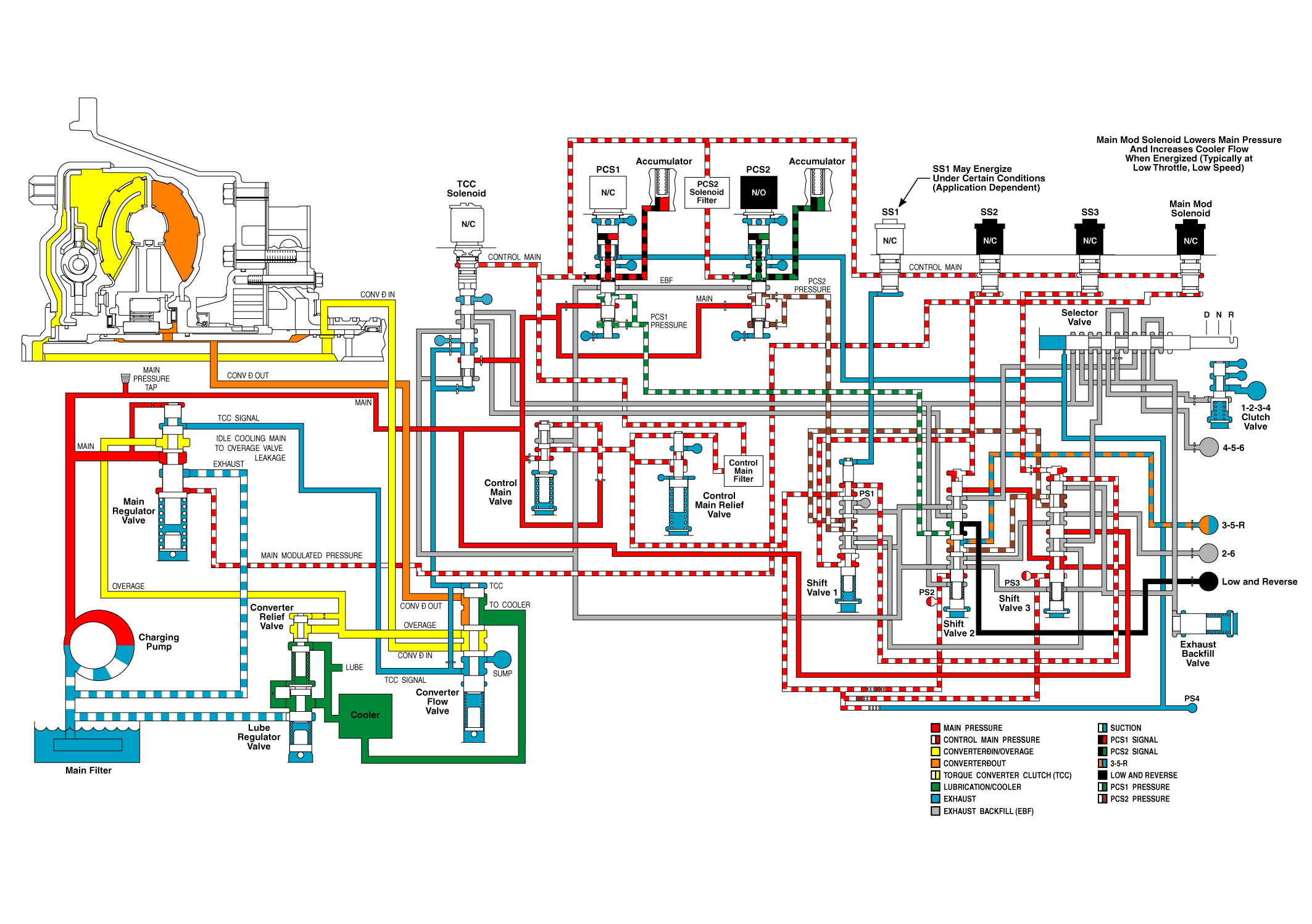When the manual selector valve is moved from Neutral (N) to Reverse (R), shift solenoid 1 (SS1) de-energizes, turning OFF pressure switch 1. SS2 and SS3 remain energized, keeping pressure switch 2 and pressure switch 3 on. Reverse signal pressure is exhausted, removing pressure from pressure switch 4, turning on the normally closed pressure switch 4.
The transmission control module (TCM) energizes pressure control solenoid 2 (PCS2) to control the rate at which PCS2 pressure supplies oil to the oncoming 3rd, 5th, and reverse clutch, assuring a smooth transition to reverse. As PCS2 is energized, PCS2 signal pressure increases. Initially, the pressure control valve 2 gain valve spring keeps the gain valve away from pressure control valve 2, so that only PCS2 signal pressure acts on pressure control valve 2. As PCS2 signal pressure increases, the PCS2 pressure increases. The PCS2 signal pressure also acts on the gain valve, stroking the valve and compressing the gain valve spring. When the gain valve spring is compressed sufficiently, the gain valve contacts pressure control valve 2. The gain valve spring allows the 3rd, 5th, and reverse clutch initial apply to be controlled at a lower gain rate, improving control of the oncoming 3rd, 5th, and reverse clutch. Once the gain valve makes contact with pressure control valve 2, PCS2 pressure increases at a higher gain rate, PCS2 pressure flows through shift valve 1 to shift valve 3 and on to apply the 3rd, 5th, and reverse clutch. When the shift to reverse is complete, PCS2 fully energizes and PCS2 pressure fully applies the 3rd, 5th, and reverse clutch. PCS1 supplies full pressure to the low and reverse clutch.
The application of the 3rd, 5th, and reverse clutch and the low and reverse clutch produces reverse range operation.
If electrical power is interrupted with the transmission operating in reverse range, PCS2, SS2, and SS3 de-energize. When PCS2 de-energizes, the normally open solenoid exhausts PCS2 signal pressure, causing pressure control valve 2 to de-stroke, exhausting and releasing the 3rd, 5th, and reverse clutch. Shift valve 1 remains in the stroked position. Control main pressure goes through shift valve 1 to the top of shift valve 3 keeping shift valve 3 stroked. Normally closed PCS1 blocks the exhaust of PCS1 signal pressure, and PCS1 pressure is maintained. PCS1 pressure continues to be directed through shift valve 2, which stays down due to the "latching" effect of pressure on two different diameter lands, to the low and reverse clutch, keeping the low and reverse clutch applied. Because only one clutch is applied, the transmission shifts to neutral range.
If electrical power is interrupted with the transmission operating in reverse range, resulting in neutral operation, main pressure is directed through shift valve 3 to shift valve 2. Because shift valve 2 stays stroked due to the "latching" effect of pressure on two different diameter lands, main pressure is blocked from reaching the manual selector valve. If the manual selector valve is moved to Neutral (N) or a forward range, the transmission remains in neutral.
If electrical power is interrupted with the transmission operating in reverse range, resulting in neutral operation, the engine may be shut down and restarted to attain neutral, third and reverse operation.
Reverse Range

